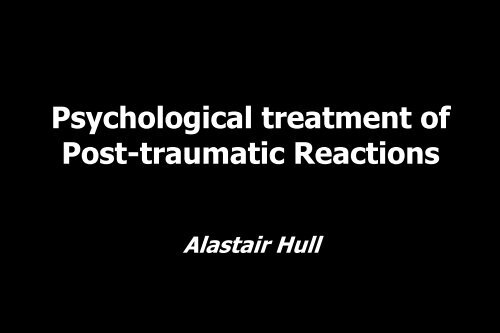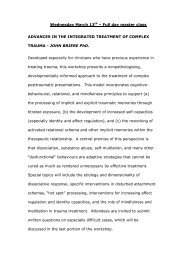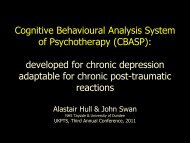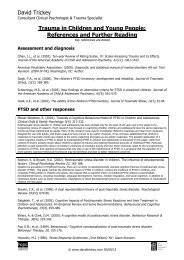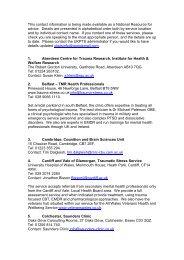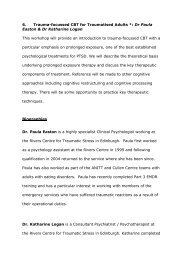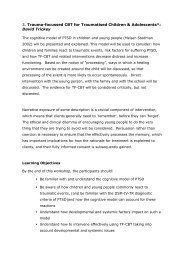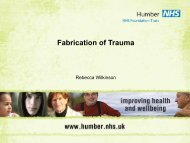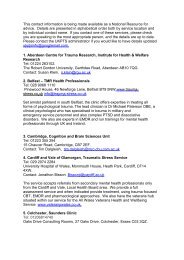Exposure - ukpts
Exposure - ukpts
Exposure - ukpts
You also want an ePaper? Increase the reach of your titles
YUMPU automatically turns print PDFs into web optimized ePapers that Google loves.
Psychological treatment of<br />
Post-traumatic Reactions<br />
Alastair Hull
Treatment for Post-traumatic<br />
• is a staged approach<br />
reactions
Time Course of Reactions<br />
Traumatic<br />
event<br />
Acute<br />
stress<br />
reaction<br />
(first<br />
48 hrs)<br />
Acute<br />
stress<br />
disorder<br />
(up to 4<br />
weeks)<br />
Acute<br />
PTSD<br />
(4-12<br />
weeks)<br />
Chronic<br />
PTSD<br />
(12 wks +)
Acute Stress Disorder<br />
• Amazingly no good studies<br />
• Ideal opportunity for major trial<br />
• Is ASD just acute PTSD?
Early Intervention<br />
• Psychological debriefing<br />
• CISD<br />
• Characterised by very early intervention<br />
“across the board” for “all or most exposed”<br />
before the development of a disorder<br />
• Cochrane review
Early Intervention<br />
Why might an intervention designed to do<br />
good, instead do harm?<br />
• Re-exposure to trauma<br />
• Disrupts natural coping style<br />
• Disrupts avoidance<br />
• Sensitizes people to expect symptoms<br />
• Suggest that normal reactions are disorders
Immediate management of PTSD<br />
• Psychological first aid<br />
– Giving information and social support as soon as<br />
possible<br />
• Avoid brief single session debriefing<br />
• Watchful waiting if symptoms are moderate –<br />
assess whether natural recovery occurs, review at<br />
one month<br />
• Screen at risk groups<br />
– Following disaster<br />
– Refugees and asylum seekers
Treatment aims to...<br />
• “normalise” reactions<br />
• enable catharsis<br />
• inspire hope, restore sense of safety &/or<br />
trust<br />
• “educate”<br />
• treat core symptoms and comorbidity<br />
• limit “kindling” of symptoms
A legion of psychological therapies...<br />
• psychoanalysis (and its derivatives)<br />
• abreaction<br />
• hypnotherapy<br />
• group variants<br />
• family/marital therapy<br />
• action-focused therapy<br />
• art therapy<br />
• psychodrama<br />
• marathon therapy
A legion of psychological therapies (ii)<br />
• thought- field therapy<br />
• "rewind" therapy<br />
• in-patient eclectic programmes<br />
• Imaginal exposure<br />
• In vivo exposure<br />
• cognitive restructuring<br />
• Eye Movement Desentization and Reprocessing<br />
(EMDR)
Metaanalysis of all treatments<br />
Van Etten & Taylor (1998)<br />
• psychological > medication > control<br />
• few RCTs for PTSD<br />
• most effective : behaviour therapy & EMDR<br />
• combination treatments ?
Psychological Treatments for<br />
PTSD<br />
APA Task Force on Promotion and<br />
Dissemination of Psychological Procedures<br />
• “no gold standard treatments” for<br />
PTSD<br />
(Chambless et al., 1996)
APA Task Force on Promotion and<br />
Dissemination of Psychological Procedures<br />
Proven Efficacy<br />
• Imaginal <strong>Exposure</strong><br />
Probably Efficacious<br />
• Cognitive restructuring<br />
• EMDR<br />
(Chambless et al., 2000)
Key points<br />
Psychological treatmentcurrent<br />
guidelines<br />
• PTSD symptoms can be very resistant to therapy<br />
• <strong>Exposure</strong> is key ingredient of successful<br />
psychological therapy<br />
• Trauma focused-CBT and EMDR are the most<br />
effective<br />
ISTSS, APA & NICE guidelines, & consensus statement
Post-traumatic Stress Disorder<br />
(PTSD)<br />
The management of PTSD in adults and<br />
children in primary and secondary care<br />
Clinical Guideline<br />
Published: March 2005<br />
www.nice.org.uk
Where is the guideline available?<br />
• Quick reference guide: summary of recommendations for health<br />
professionals:<br />
– www.nice.org.uk/cg026quickrefguide<br />
• NICE guideline<br />
– www.nice.org.uk/cg026niceguideline<br />
• Full guideline: all of the evidence and rationale behind the<br />
recommendations:<br />
– www.rcpsych.ac.uk/publications<br />
• Information for the public: plain English version for sufferers, carers and<br />
the public<br />
– www.nice.org.uk/cg026publicinfoenglish
Treatment is difficult because of...<br />
• unrealistic expectations<br />
• delayed treatment<br />
• poor compliance or premature discontinuation of Rx<br />
• co-morbidity<br />
• “re-traumatisation”<br />
• denial and “stiff upper lip”<br />
• unworthy of help due to guilt<br />
• loss of trust in authority figures or members of<br />
opposite sex<br />
• prolonged legal and compensation procedures<br />
• credibility of treatment
“...... he should see whether or not it was<br />
possible to make them [traumatic<br />
memories] tolerable, if not even<br />
pleasant companions, instead of evil<br />
influences which forced themselves<br />
upon his mind."<br />
(Rivers, 1918)
Stages of Treatment<br />
1. engagement<br />
2. normalisation/crisis stabilisation (if<br />
necessary)<br />
3. strategies to manage symptoms<br />
4. trauma-focused CBT, including,<br />
5. cognitive restructuring<br />
6. ongoing support
Assessment 1<br />
Ready for treatment<br />
YES<br />
NO<br />
Assessment 2<br />
Trauma Story<br />
Support /<br />
Monitor<br />
EMDR<br />
Cognitive<br />
Therapy<br />
Behaviour<br />
Therapy<br />
Drugs<br />
Normalisation<br />
Vulnerability<br />
Responsibility<br />
Appraisal of trauma<br />
Survival behaviour<br />
Avoidance<br />
Anxiety reduction<br />
<strong>Exposure</strong><br />
Activity schedules<br />
Stress inoculation<br />
training<br />
SSRIs<br />
Carbamazepine<br />
Relapse prevention<br />
Follow-up
NCCMH guidelines for<br />
Psychological treatment<br />
Key points<br />
• Trauma-focused treatments either CBT or EMDR should be<br />
offered<br />
• Offer regardless of time lapse since TE<br />
• Rx should be long enough, regular, with same therapist<br />
• Extend beyond 12 sessions if complex<br />
• If necessary, establish a therapeutic relationship before trauma<br />
material is directly addressed<br />
• Non-trauma focused interventions should not routinely be<br />
offered<br />
• Augmentation with medication if failure to respond to above<br />
National Collaborating Centre for Mental Health, 2005
CBT for PTSD: an overview<br />
Treatment programmes vary<br />
• prolonged exposure (PE) alone<br />
‣includes both in vivo exposure and imaginal<br />
exposure<br />
‣in vivo exposure (exposure in reality to feared<br />
situations)<br />
‣imaginal exposure (repeated reliving of the trauma)<br />
• PE plus cognitive restructuring<br />
• PE plus Stress Inoculation training (SIT)<br />
• EMDR can be used as substitute for imaginal<br />
exposure
CBT for PTSD: an overview (ii)<br />
How to choose?<br />
• prolonged exposure (PE) alone<br />
‣ more is not necessarily better<br />
‣ research shows these 2 exposure approaches are very<br />
effective
CBT for PTSD: an overview (iii)<br />
How to choose?<br />
• prolonged exposure (PE) alone<br />
– more is not necessarily better<br />
– research shows these 2 exposure approaches are very<br />
effective<br />
• PE plus cognitive restructuring<br />
‣ very effective for patients whose major problems lie in<br />
their dysfunctional thoughts, producing guilt and shame<br />
‣ and, in those with comorbid anxiety disorders
CBT for PTSD: an overview (iv)<br />
How to choose?<br />
• prolonged exposure (PE) alone<br />
– more is not necessarily better<br />
– research shows these 2 exposure approaches are very<br />
effective<br />
• PE plus cognitive restructuring<br />
• PE plus Stress Inoculation Training (SIT)<br />
‣ in those with extreme continuous tension- often reluctant<br />
to engage in exposure until arousal levels are decreased<br />
‣ Efficacy of components of SIT not established but in<br />
combination with cognitive restructuring is effective
Specific considerations in<br />
applying CBT for PTSD<br />
• reluctance to attend sessions that focus on<br />
confrontation with the Traumatic event<br />
‣ allow more cancellations and appt changes than usual, call<br />
clients who don’t attend<br />
• after some traumatic events fears are rooted in<br />
reality<br />
‣ assess prior to in vivo hierarchy<br />
‣ think in terms of “an acceptable level of risk”<br />
• N.B., the traumatic event actually occurred<br />
‣so can be difficult to use cognitive techniques to<br />
change patient’s perception
Overview of CBT programme<br />
• assessment<br />
• stabilisation and balance<br />
• psychoeducation<br />
• managing symptoms, e.g., thought stopping<br />
• rationale for IE, in vivo exposure, cognitive restructuring<br />
• handout on post-traumatic reactions<br />
• breathing retraining, relaxation<br />
• construct and carry out in vivo hierarchy<br />
• conduct IE<br />
• conduct cognitive restructuring
Stabilisation and balance
Self<br />
actualisation<br />
self esteem<br />
affiliation<br />
safety<br />
physiological needs<br />
Maslow’s Hierarchy of Needs (1970)
Pragmatic<br />
• Physical safety<br />
• Emotional safety<br />
‣Professional or social support<br />
• Problem solving<br />
• Educate partner or family<br />
• Healthy pleasures- modest goals<br />
• Daily routine, spending time with other people<br />
not talking about trauma, structuring day.<br />
• N.B., many are depressed
Pragmatic……….(ii)<br />
• compensation proceedings<br />
• occupational health
TLC…. of self<br />
• Exercise<br />
– Don’t advise until assessed whether<br />
hyperventilate and if they do, commence<br />
breathing training<br />
• Sleep hygiene<br />
– Be aware the bedroom may be a potential<br />
trigger<br />
• Nutrition
Psychoeducation
Psychoeducation<br />
• appropriate accurate information<br />
‣ police, A&E, paramedics, eye witness(es)<br />
‣ Media reports, FAI, occasionally video footage (CCTV)<br />
‣ N.B., can lead to incorporation in memory<br />
‣Warn of potential medicolegal implications<br />
‣Crown Office guidance<br />
‣Check for gaps in sequential memory first<br />
‣May be gaps in memory or gaps in understanding<br />
‣LoC does not preclude PTSD<br />
• healing metaphor<br />
• range of responses to threat
Psychoeducation<br />
• appropriate accurate information<br />
• healing metaphor<br />
• range of responses<br />
• reason for response…. ”why me?”
trauma<br />
vulnerability<br />
Edna Foa, 1994
Psychoeducation<br />
• appropriate accurate information<br />
• healing metaphor<br />
• range of responses<br />
• reason for response<br />
• phases of response
Adaptation after traumatic events<br />
time<br />
Raphael
Psychoeducation<br />
• appropriate accurate information<br />
‣police, A&E, paramedics, eye witness(es)<br />
• healing metaphor<br />
• range of responses<br />
• reason for response<br />
• phases of response<br />
• memory<br />
‣“feels like yesterday”
Limbic system<br />
gustatory<br />
visual auditory olfactory kinesthetic
Limbic system<br />
gustatory<br />
visual auditory olfactory kinesthetic
“it feels like yesterday”<br />
• Broca’s area decreased rCBF<br />
• predominance of emotional areas of brain<br />
over higher cortical areas<br />
• fragmented memories<br />
• emotional memory on RHS brain<br />
• dissociation
Psychoeducation<br />
• appropriate accurate information<br />
‣ police, A&E, paramedics, eye witness(es)<br />
• healing metaphor<br />
• range of responses<br />
• reason for response<br />
• phases of response<br />
• memory<br />
‣ “feels like yesterday”<br />
‣ “filing cabinet” metaphor<br />
‣ “curtained room” metaphor
Psychoeducation<br />
• appropriate accurate information<br />
• healing metaphor<br />
• range of responses<br />
• reason for response<br />
• phases of response<br />
• memory<br />
‣ “feels like yesterday”<br />
‣ “filing cabinet” metaphor<br />
‣ “curtained room” metaphor<br />
• core symptoms<br />
‣ Claudia Herbert’s book<br />
• educate partner and/or family
Model of emotional disorders<br />
Cognition<br />
Environment<br />
Behaviour<br />
Emotion<br />
Biological<br />
Padesky & Greenberger, 1996
Managing symptoms
Relaxation<br />
For example.,<br />
• PMR<br />
• N.B., physical injuries<br />
• imagery<br />
• trauma survivors often<br />
become very good at<br />
imagery
Relaxation<br />
Limitations<br />
• can provoke relaxation-induced anxiety in<br />
some clients<br />
• less effective than other therapies<br />
• adjunct rather than central therapy
PMR for trauma survivors<br />
• tensing in PMR might trigger anxiety in some<br />
people<br />
‣Use calming self-statements<br />
‣“I am safe now; tension is just a reminder of an<br />
old memory”<br />
• keep eyes open as you practice<br />
• start with briefer periods of practice<br />
• keep a record of relaxation<br />
‣Progress can be very motivating
Visualisation<br />
• Mindfulness techniques<br />
• Light stream technique…
Managing Intrusive Thoughts<br />
• Cannot avoid thinking about TE completely<br />
• Thinking about it at times is important<br />
• Prescribe 30mins per day if too many intrusive<br />
thoughts<br />
• Strategies are required to limit them at other times<br />
to limit interference with other activities<br />
• Distraction techniques/activities<br />
– Absorbing activity, especially if physical and mental<br />
aspect (e.g., juggling)<br />
– Mental distraction techniques useful as can use without<br />
others noticing
Managing Intrusive Thoughts<br />
Strategies<br />
• focus on small area and describe in detail<br />
• focus on surroundings with all senses<br />
– describe in detail everything can see, hear, smell, touch,<br />
taste<br />
– this keeps in touch with “here and now” reality<br />
– mental exercises such as serial 7s, animal A-Z<br />
– describe happy memory in detail to self<br />
– describe a safe place (relaxed and happy)<br />
• Thought stopping<br />
– especially for constant thoughts or ruminations
Managing Intrusive Thoughts<br />
Thought stopping<br />
• Especially for constant thoughts or ruminations<br />
• Elastic band & stop<br />
– Gradually say it quieter and quieter<br />
– After 10-15 times just saying it to self<br />
– Snap band each time<br />
• Non-dominant hand writing
Memory work
Cognitive Processing- very briefly<br />
• developed by Resick & Schnicke (1992, 1993)<br />
• incorporates elements of CT and Ex.<br />
• CT<br />
• Ex<br />
challenging problematic cognitions such<br />
as self-blame and undoing of the TE<br />
writing a detailed account of the TE and<br />
reading it to the therapist and at home.<br />
Used to provoke affect and identify “stuck<br />
points” for CT
Cognitive restructuring<br />
- very briefly
Cognitive Restructuring<br />
Key features are<br />
• a focus on the meaning of trauma to the patient<br />
• a systematic attempt to modify patients’ false<br />
assumptions<br />
• an attempt to help the patients to achieve a realistic<br />
view of themselves, their environment and their<br />
future<br />
• patients are encouraged to keep diaries or records<br />
to carry out assignments
Cognitive Therapy<br />
Limitations<br />
• may require to be used in combination with<br />
<strong>Exposure</strong><br />
N.B.,<br />
• Whilst not empirically validated the impression is<br />
that CR appears to occur parallel to or after<br />
successful <strong>Exposure</strong>- the relationship is a complex<br />
one.
Common dysfunctional beliefs &<br />
associated negative thoughts in PTSD<br />
Pre-trauma beliefs about the safety of the world<br />
PTSD is likely to occur if:<br />
• pre-trauma the person viewed the world as a dangerous<br />
place and the TE validates this<br />
• pre-trauma view that the world was safe and the TE<br />
shatters this belief<br />
• in both instances the person overgeneralises to being in constant<br />
danger and there is no safe place in the world<br />
• results in extreme fear, avoidance and chronic hyperarousal<br />
• specific beliefs reflect the general belief so that:<br />
‣ “all men are potential rapists”,<br />
‣ “the streets are unsafe”,<br />
‣ “cars are death-traps” or<br />
‣ “sleeping in the dark is dangerous”
Common dysfunctional beliefs &<br />
associated negative thoughts in PTSD<br />
Pre-trauma beliefs about the safety of the world<br />
PTSD is likely to occur if:<br />
• pre-trauma the person viewed the world as a dangerous<br />
place and the TE validates this<br />
• pre-trauma view that the world was safe and the TE<br />
shatters this belief<br />
• in both instances the person overgeneralises to being in constant<br />
danger and there is no safe place in the world<br />
• results in extreme fear, avoidance and chronic hyperarousal<br />
• specific beliefs reflect the general belief so that:<br />
‣ “all men are potential rapists”,<br />
‣ “the streets are unsafe”,<br />
‣ “cars are death-traps” or<br />
‣ “sleeping in the dark is dangerous”
Cognitive restructuring: aims and methods<br />
• correct mistaken beliefs such as<br />
– “the world in entirely dangerous” or “I am totally incompetent”<br />
• Goal is to reduce anxiety or emotional distress by teaching<br />
clients to identify, evaluate and modify negative thoughts and<br />
dysfunctional beliefs<br />
• teaches the patient to develop more realistic beliefs about<br />
ability to cope and the safety of the world<br />
• Work together with negative thoughts and beliefs treated as<br />
hypotheses<br />
• Collect evidence to determine whether the patient’s<br />
conclusions are accurate and useful
<strong>Exposure</strong><br />
Various terms for exposure to anxietyprovoking<br />
stimuli without relaxation….<br />
• prolonged exposure<br />
• Imaginal exposure<br />
• in vivo exposure<br />
• flooding<br />
• EMDR<br />
• Virtual reality
Prolonged <strong>Exposure</strong><br />
• proven efficacy across a range of trauma<br />
• includes imaginal exposure and in vivo<br />
exposure<br />
• involves development of anxiety hierarchy<br />
‣ continued exposure (in controlled fashion) to<br />
frightening stimulus<br />
‣ leads to decreased anxiety (habituation)<br />
‣ and then decrease in avoidance behaviour
<strong>Exposure</strong><br />
Evidence strongly supports use of combined in<br />
vivo and imaginal exposure<br />
• Not widely used by clinicians<br />
• Becker et al (2004) found 80% of psychologists did<br />
not use IE in Rx of PTSD<br />
•
<strong>Exposure</strong><br />
Evidence strongly supports use of combined in<br />
vivo and imaginal exposure<br />
Why not used more?<br />
Apprehensions of clinicians<br />
– ability to conduct effectively<br />
– ability to appropriately manage any problematic reactions<br />
– Therapist avoidance rather than habituation?
<strong>Exposure</strong><br />
Limitations<br />
• realities of life e.g., rural life<br />
• reluctance of some survivors to confront<br />
reminders and tolerate high anxiety<br />
• may not be effective if guilt, shame or anger<br />
is the primary emotion<br />
• care must be taken not to “re-traumatise”<br />
the patient
in vivo exposure<br />
briefly
in vivo exposure<br />
• approach/ procedure is largely consistent across<br />
disorders<br />
• if use it for agoraphobic avoidance should have<br />
little trouble translating the technique to PTSD
Overview of in vivo exposure<br />
1. present the rationale<br />
2. introduce SUDs<br />
3. construct a hierarchy of avoided<br />
situations, people and places using SUDs.<br />
4. develop homework assignment based on<br />
this hierarchy<br />
5. instruct patient in in vivo exposure…….
Overview of in vivo exposure<br />
6. instruct patient in in vivo exposure<br />
‣Remind that not every situation needs to be<br />
included<br />
‣the list is representative to teach idea behind in<br />
vivo exposure<br />
‣however, make sure that items with SUDs of 50,<br />
60, 70, 80, 90 & 100 (or thereabouts)<br />
• these are the major foci of treatment
in vivo exposure instruction<br />
• patient begins with situation that evokes moderate<br />
anxiety levels (SUDs = 50)<br />
• patient puts him/herself into anxiety provoking (but<br />
realistically safe) situation<br />
• patient records time and initial SUDs rating<br />
• patient must remain in situation for 30-45 mins<br />
– Emphasise the importance of remaining in the situation until<br />
anxiety/SUDs decreases by at least 50%<br />
– Do not want them to leave the situation and feel relief but to<br />
habituate to the situation<br />
• Patient records endpoint SUDs rating
in vivo exposure instruction<br />
• The intention is that the client is exposed to<br />
intermediate levels of “fear”<br />
– Not too great to prevent processing<br />
– Not too slight that they are not engaging<br />
• If use relaxation techniques during in vivo<br />
exposure use only to keep “fearfulness” at<br />
intermediate level.
imaginal exposure
Evidence base for <strong>Exposure</strong><br />
N.B., most research evidence supporting exposure in<br />
PTSD employs combination of IE and in vivo exposure<br />
• No other treatment has such strong support<br />
• Systematic reviews<br />
– (Foa et al, 2000; Keane, 1998, Sherman, 1998, van Etten &<br />
Taylor, 1998)<br />
• Research groups in<br />
– America (Foa et al, 1991; 1999; Resick et al, 2002)<br />
– UK (Marks et al, 1998; Tarrier et al, 1999)<br />
– Australia (Bryant et al, 2003)<br />
• Research on IE alone<br />
– (Cloitre et al, 2002; Tarrier et al, 1999; Bryant et al, 2003)
Rationale for Imaginal <strong>Exposure</strong><br />
• Involves the patient being asked to recount<br />
the TE in detail<br />
• To maximise efficacy of IE<br />
– need to maximise stimulus cues (e.g., sights,<br />
sound, smells)<br />
– and response cues (e.g., cognitions, affect,<br />
somatic sensations)
Dual Representation Theory of Trauma<br />
Memory<br />
Verbally accessible<br />
trauma memories (VAM)<br />
Intrusive memories<br />
of conscious experience<br />
Emotions related to trauma<br />
Selective recall<br />
Stimuli Meaning analysis Selective attention Contents of<br />
relevant<br />
consciousness<br />
to prior<br />
Priorities for<br />
trauma processing Selective attention<br />
Situationally<br />
accessible<br />
trauma memories<br />
Flashbacks<br />
Dream material<br />
Trauma specific emotion<br />
Selective recall<br />
Physiological arousal<br />
Motor output<br />
Brewin, Dalgleish & Joseph, 1996
Rationale for Imaginal <strong>Exposure</strong><br />
Based on principles of<br />
• information processing<br />
– traumatic memory network is activated through<br />
exposure<br />
– It is modified by re-evaluating old information (VAM)<br />
– & incorporating new information (SAM)<br />
– shows that thinking about the assault is not<br />
dangerous<br />
• habituation<br />
– Prolonged and repeated exposure lowers anxiety and<br />
disconfirms that anxiety will last forever
Dual Representation Theory of Trauma<br />
Memory<br />
Re-evaluate<br />
Verbally accessible<br />
trauma memories (VAM)<br />
Intrusive memories<br />
of conscious experience<br />
Emotions related to trauma<br />
Selective recall<br />
Stimuli Meaning analysis Selective attention Contents of<br />
relevant<br />
consciousness<br />
to prior<br />
Priorities for<br />
trauma processing Selective attention<br />
Situationally<br />
accessible<br />
trauma memories<br />
Flashbacks<br />
Dream material<br />
Trauma specific emotion<br />
Selective recall<br />
Physiological arousal<br />
Motor output<br />
Brewin, Dalgleish & Joseph, 1996
Dual Representation Theory of Trauma<br />
Memory<br />
Verbally accessible<br />
trauma memories<br />
Intrusive memories<br />
of conscious experience<br />
Emotions related to trauma<br />
Selective recall<br />
Stimuli Meaning analysis Selective attention Contents of<br />
relevant<br />
consciousness<br />
to prior<br />
Priorities for<br />
trauma processing Selective attention<br />
incorporate<br />
Situationally<br />
accessible<br />
trauma memories<br />
(SAM)<br />
Flashbacks<br />
Dream material<br />
Trauma specific emotion<br />
Selective recall<br />
Physiological arousal<br />
Motor output<br />
Brewin, Dalgleish & Joseph, 1996
Yet another paradox in PTSD<br />
Why does re-experiencing not lead to<br />
habituation?<br />
• Increased levels of arousal & distress<br />
• Sufferer struggles to dismiss painful memories<br />
or images<br />
• Terminates re-experiencing when anxiety still<br />
very high-<br />
– this can incubate the anxiety
Rationale for Imaginal <strong>Exposure</strong><br />
• discriminates between remembering and being<br />
re-traumatised<br />
• increased mastery<br />
– enhances sense of self-control and competence<br />
• discrimination<br />
– exposure will decrease the generalisation from specific<br />
to similar but safe situations<br />
• intrusive, distressing traumatic memories are the<br />
primary feared stimuli in PTSD<br />
– can not be confronted in vivo
Rules for Imaginal <strong>Exposure</strong><br />
• IE should be graded – optimal SUDs = 70<br />
– Generate a hierarchy whether for single (less needed on<br />
occasions) or multiple traumas<br />
• IE should be prolonged<br />
• IE should be repeated (including as homework)<br />
– Usually 3-4 on same stimulus<br />
• IE should be functional<br />
– meaning all aspects of trauma memory are accessed<br />
(especially accompanying affect)<br />
– a moderately high level of arousal will be needed<br />
– this is harder in IE than in vivo<br />
– may mean new material comes up
Overview of imaginal exposure (i)<br />
1. present the rationale for imaginal exposure<br />
2. be alert to patient’s anxiety - provide reassurance<br />
3. explain that the session will be audiotaped for their use as<br />
homework (NB should note SUDs)<br />
4. Sessions 1-2 ask patient to describe the trauma with eyes<br />
open<br />
5. Sessions 1-2 ask patient to recall the trauma in the past<br />
tense<br />
6. i.e., IE sessions 1 & 2 allow them to approach the memory<br />
gradually & determine the level of detail<br />
7. Later sessions – eyes closed & recall the trauma in<br />
present tense
Overview of imaginal exposure (ii)<br />
8. in IE session 3 onwards ask probing questions<br />
regarding the emotional and physiological reactions<br />
9. every few minutes do a SUDs<br />
10. continue for 30-60mins<br />
– terminate by asking them to open their eyes and take a breath and<br />
“let it go”<br />
– allow time after IE for patient to become calm<br />
– leave enough time for session
Eye Movement Desensitisation<br />
& Reprocessing (EMDR)<br />
…..for PTSD
EMDR: what is it?<br />
• a cognitive-behavioural technique<br />
• it essentially combines elements of<br />
cognitive therapy with exposure<br />
• But it is more than pure exposure<br />
– i.e., speed of change<br />
– dual-attentional focus
Introduction<br />
• “doses” of exposure<br />
• may be highly effective after only a few sessions<br />
• large number of controlled studies supporting the<br />
use of EMDR in PTSD.
What is EMDR & what is its<br />
theoretical basis ?<br />
• a package of therapeutic elements<br />
• unclear whether eye movements are needed<br />
• other forms of lateral stimulation, e.g. finger<br />
taps, may be equally effective<br />
• rapid left-right sensory stimulation in<br />
some modality does seem to facilitate<br />
information processing
Role of eye movements ?<br />
Possibilities ……<br />
• distraction from anxiety might produce<br />
change given right expectations<br />
• <strong>Exposure</strong> technique (s)<br />
‣research has not supported other<br />
distraction techniques as beneficial<br />
‣experience of EMDR is not being<br />
distracted from it, experiencing it more
Shapiro's Accelerated Information<br />
Processing (AIP) model<br />
• traumatic experiences are held<br />
dysfunctionally in the nervous system<br />
where they are blocked from being<br />
processed due to the way in which<br />
traumatic experiences are encoded in the<br />
brain<br />
• removing the blockage through EMDR results<br />
in healthy adaptation
Shapiro's Accelerated Information<br />
Processing (AIP) model<br />
• neurological model is a construct to help<br />
others to understand.<br />
• uses neuro-physiological language but it is a<br />
metaphor which makes allusions to the<br />
physiological mechanisms in the brain
Components of EMDR<br />
<strong>Exposure</strong><br />
• focus is on a picture epitomising the trauma<br />
• emotions & physical sensations linked to the<br />
trauma are identified and rated<br />
• subjective evaluation of physiological<br />
reactions (SUDS)<br />
• information processing is facilitated in dosed,<br />
short exposures
Components of EMDR<br />
Cognitive restructuring<br />
• a negative cognition is elicited<br />
• an alternative positive cognition is identified<br />
and rated for validity (VoC)<br />
• Cognitive interweave during EMDR
EMDR<br />
• if EMDR preferred by patients and clinicians then it<br />
is likely to be used more than IE<br />
• Non-directive (patient in control and creating own<br />
healing atmosphere) i.e., therapist stays out of the<br />
way.<br />
• EMDR as a process is both experience (i.e., nonreflective<br />
“doing”) and reflection (i.e., intending<br />
and reflecting upon the “doing”). This is done in<br />
small doses<br />
• Emphasis on movement of information, working on<br />
past, present & future<br />
– This is the standard EMDR protocol
EMDR<br />
• Guilt is prominent in PTSD - EMDR helpfully<br />
incorporates exposure and cognitive therapy<br />
elements<br />
• “unspeakable” nature of some phases of PTSD<br />
suggests the use of exposure techniques such as<br />
EMDR<br />
• importantly, the reactivation of memory does<br />
not require it to be put into communicable language
Summary (i)<br />
• a package of therapeutic elements<br />
• unclear whether eye movements are needed<br />
• other forms of lateral stimulation, e.g. finger taps,<br />
may be equally effective<br />
• rapid left-right sensory stimulation in some modality<br />
does seem to facilitate information processing<br />
• Cognitive components stressed as important (i.e.,<br />
PC & NC, and cognitive interweave)<br />
• Performed in the here and now using affect and<br />
sensations
Summary (ii)<br />
• EMDR is more than pure exposure.<br />
• Gains in EMDR treatment are achieved more quickly<br />
than in controlled exposure studies<br />
• <strong>Exposure</strong> in EMDR comes in short doses and<br />
includes a cognitive component not evident in<br />
flooding<br />
• EMDR and traditional exposure therapies appear<br />
roughly equal in effectiveness
Summary of psychological<br />
treatments for PTSD
Summary of psychological<br />
treatments (i)<br />
• well established treatments but no panacea<br />
• <strong>Exposure</strong>, EMDR and CT are the central<br />
treatments<br />
• problem based treatment better than<br />
concentrating on “core criteria”
Summary of psychological<br />
treatments (ii)<br />
• non-core symptoms may be significant source of<br />
distress<br />
• specific protocols exist for particular symptoms<br />
• guilt may be pervasive and chronic<br />
• exposure programs can be limited by the realities of<br />
life<br />
• combination therapies not yet shown to confer an<br />
advantage.<br />
‣may be due to decreased time spent on each<br />
component
and lest we forget…..<br />
Impact of trauma care on staff<br />
• most will cope<br />
• possible burnout<br />
• senior staff are not<br />
impervious<br />
• a balance between empathy<br />
and professional distance<br />
• treating trauma survivors<br />
shows us resilience - “gifts”<br />
of viewing +ve adaptation<br />
for those in the trenches


